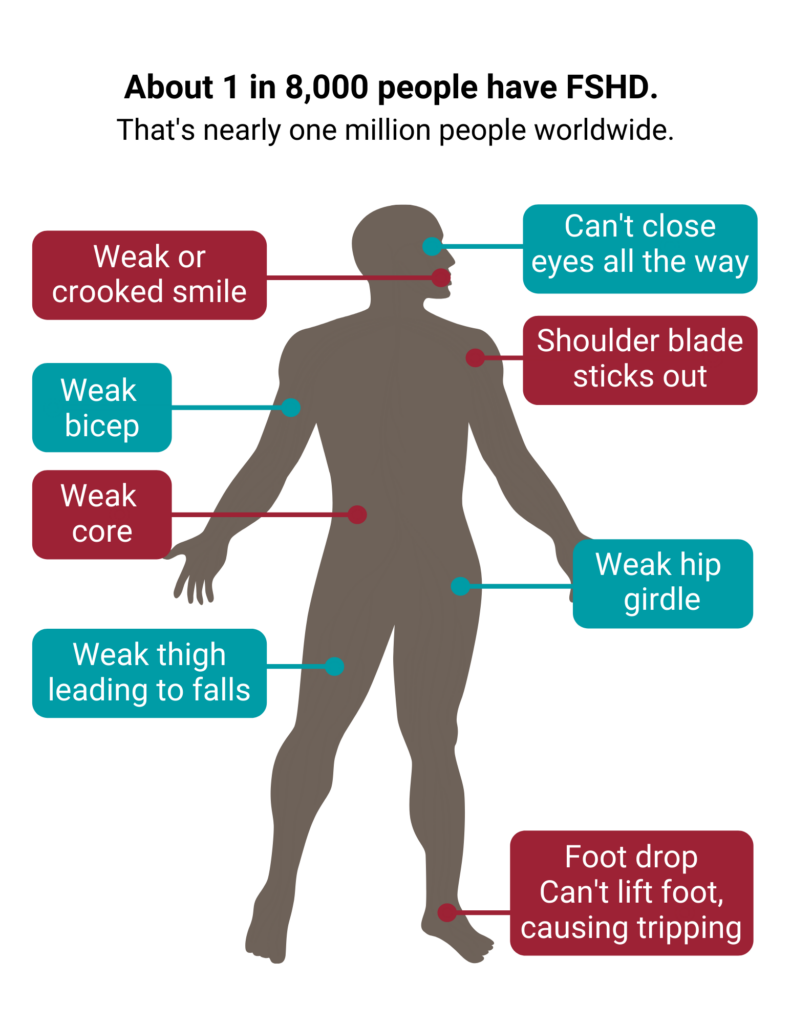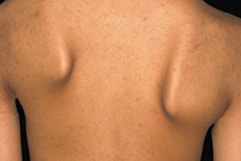We can help.
The FSHD Society's promise is to do all it can to ensure no patient need ever face Facioscapulohumeral muscular dystrophy alone.
Facioscapulohumeral muscular dystrophy (also known as FSH muscular dystrophy or FSHD) is classified as a neuromuscular disease (NMD), as are all types of muscular dystrophy. Muscular dystrophies are marked by progressive skeletal muscle weakness, defects in the physical components of muscle, and the degeneration of muscle cells and tissue. FSHD affects both males and females, with symptoms most often becoming noticeable during adolescence and early adulthood. Around 5% develop symptoms before age 10, while there are also seniors whose symptoms are so mild that they may never realize they have FSHD.

Have you been experiencing any of these symptoms?
If you have been noticing any of these symptoms and are seeking answers, it may help for you to track what you are experiencing and take it to your doctor.
We have a very simple symptom tracker you can use to help. Just fill out the form to get the free download. It will help you track what you are experiencing and be a useful guide to a conversation with your healthcare team.
A common first sign of FSHD, asymptomatic scapular fixator causing scapular winging and difficulty reaching above the shoulder level. Note asymmetry.
FSHD gets its name because the muscle loss is usually noticeable across facial (facio), back (scapula), and upper arm (humeral) muscles, but other areas, such as the abdominal core, hip girdle, and legs are also commonly affected. Muscle weakness typically sets in asymmetrically, affecting only one arm or one leg, for example. Symptoms may appear years before a formal diagnosis by a doctor.
These can (but don’t always) include:

- Inability to whistle;
- Inability to sip through a straw;
- Eyes that don’t close fully during sleep;
- Difficulty with sit-ups and pull-ups;
- Shoulder blades that “wing” out;
- Difficulty raising arm above shoulder height;
- Weakness in hands and fingers;
- Foot drop (foot dorsiflexion weakness);
- Weak lower abdominal muscles, “pregnant” belly;
- Loss of chest (pectoral) muscles;
- Sunken breastbone (pectus excavatum);
- Curved spine (lordosis, kyphosis, scoliosis);
- Chronic fatigue;
- Pain, often severe (reported in 70% of patients).
Patients can also experience:
- Episodes of “malaise” or “burning pain” in muscles;
- Frequent falls, with legs just “giving out” without warning;
- Breathing problems;
- Hearing loss;
- Coats’ disease (retinal telangiectasis), which is rare, see Infantile FSHD;
- Mild cardiac arrhythmia (5-9% of patients).
Early on, symptoms can be overlooked or mistaken for an injury, and many doctors are unfamiliar with FSHD, so it may take a long time (9 years on average) before the condition is correctly diagnosed. Pain and fatigue can be a significant factor, often under-appreciated, in limiting daily activities. Loss of facial expression and mobility, as well as others’ lack of understanding, can be emotionally distressing and cause people to withdraw socially. Finding social support is life-changing for many, which is why the FSHD Society strongly encourages patients to join a local chapter or one of the many online groups where people can share their experiences and knowledge with one another.
Watch our “FSHD 101” video to learn more:
Additional information
- Download our brochure About FSHD (Download in Spanish)
- Download our Physical Therapy and FSHD brochure
- Diagnosis
- Genetic testing
- Infantile FSHD

